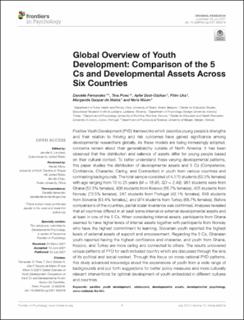| dc.description.abstract | Positive Youth Development (PYD) frameworks which describe young people's strengths and their relation to thriving and risk outcomes have gained significance among developmental researchers globally. As these models are being increasingly adopted, concerns remain about their generalizability outside of North America. It has been observed that the distribution and salience of assets differ for young people based on their cultural context. To better understand these varying developmental patterns, this paper studies the distribution of developmental assets and 5 Cs (Competence, Confidence, Character, Caring, and Connection) in youth from various countries and contrasting backgrounds. The total sample consisted of 4,175 students (62.5% females) with age ranging from 15 to 25 years (M = 18.95, SD = 2.49). 981 students were from Ghana (52.5% females), 900 students from Kosovo (66.7% females), 425 students from Norway (73.5% females), 247 students from Portugal (42.1% females), 648 students from Slovenia (63.4% females,), and 974 students from Turkey (68.7% females). Before comparisons of the countries, partial scalar invariance was confirmed. Analyses revealed that all countries differed in at least some internal or external developmental assets and at least in one of the 5 Cs. When considering internal assets, participants from Ghana seemed to have higher levels of internal assets together with participants from Norway who have the highest commitment to learning. Slovenian youth reported the highest levels of external assets of support and empowerment. Regarding the 5 Cs, Ghanaian youth reported having the highest confidence and character, and youth from Ghana, Kosovo, and Turkey are more caring and connected to others. The results uncovered unique patterns of PYD for each included country which are discussed through the lens of its political and social context. Through this focus on cross-national PYD patterns, this study advanced knowledge about the experiences of youth from a wide range of backgrounds and put forth suggestions for better policy measures and more culturally relevant interventions for optimal development of youth embedded in different cultures and countries. | en_US |

